In the heart of Cambodia’s iconic Angkor Temple complex, a remarkable discovery has emerged that connects the ancient past with the present. Archaeologists have unearthed the torso of a Buddha statue that matches a head found nearly a century ago, offering a rare glimpse into the craftsmanship and spirituality of the 12th or 13th century. This unexpected find not only sheds light on the artistic achievements of the Khmer Empire but also presents an exciting opportunity to reunite two long-separated pieces of history.
Unveiling the Buddha Statue at Ta Prohm
The recent discovery of the Buddha statue’s torso was made during a joint excavation by Cambodian and Indian archaeologists at the Ta Prohm Temple. The statue stands at an impressive height of 1.16 meters (3.8 feet) and is carved in the Bayon art style, a distinctive style associated with Angkor’s Bayon Temple. This style is known for its intricate designs, and this statue’s features include ornate jewelry, a robe, and a sash. One of the most intriguing aspects of this statue is the unique left-hand gesture across the chest, a gesture that is rarely seen in Khmer art.
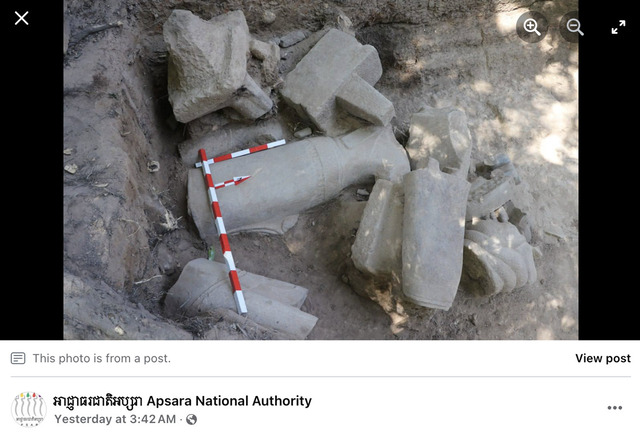
The torso was found along with 29 fragments, potentially from the same statue, adding to the mystery and grandeur of the find. This discovery is significant not only for its size but also for its depiction of Buddhist iconography, a vital aspect of Cambodia’s religious and cultural identity.
Video
Watch the video compilation about a lost empire discovered hidden under the jungle and a mummy found inside a Buddha statue.
The Puzzle of the Missing Parts: A Century-Long Mystery
The torso of the Buddha statue might seem like an isolated find, but it holds a deeper connection to the past. The head of the same statue was discovered back in 1927 during French colonial rule and has been preserved at Cambodia’s National Museum in Phnom Penh. This long-forgotten piece of the statue, separated for nearly a century, piqued the curiosity of many. When the torso was uncovered, archaeologists immediately began comparing the two pieces, and an optical electronic scan confirmed that they belonged together. This incredible discovery provides a rare opportunity to reunite the statue and fill in the gaps of its long-lost history.
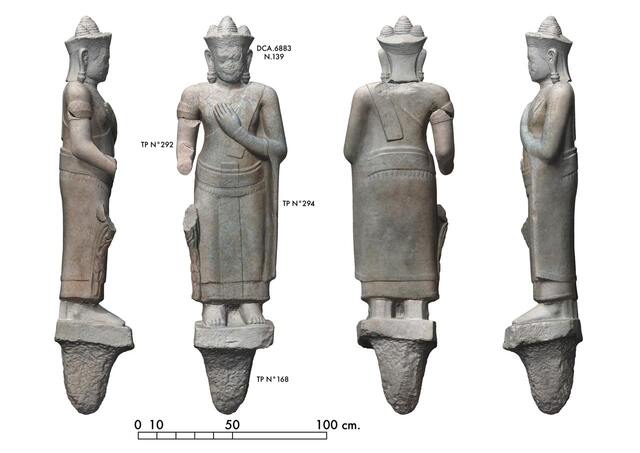
The question remains: how did the head and torso end up so far apart? The head was found approximately 50 meters from the torso, and the mystery surrounding their separation only adds to the intrigue of the find. The collaboration between archaeology teams, along with modern scanning technology, allows the two pieces to be virtually reunited before being physically restored.
The Artistic and Symbolic Significance of the Statue
The Buddha statue’s Bayon art style represents the unique blending of local Khmer artistry and the broader Southeast Asian Buddhist influence. The left-hand gesture, a distinctive feature of the statue, is not common in the typical representations of the Buddha found in other Khmer sculptures. This hand position, lightly placed on the chest, may symbolize a rare Buddhist mudra or gesture associated with compassion or spiritual awakening.
The intricate carvings on the statue’s robe and jewelry also highlight the expertise of Khmer artisans. These features indicate the wealth and cultural significance of the period during the reign of King Jayavarman VII, who was instrumental in promoting Buddhism throughout the Khmer Empire. The statue’s unique style and its connection to one of the most powerful kings in Southeast Asia’s history provide insight into the sophisticated artistry and religious practices that flourished during this era.
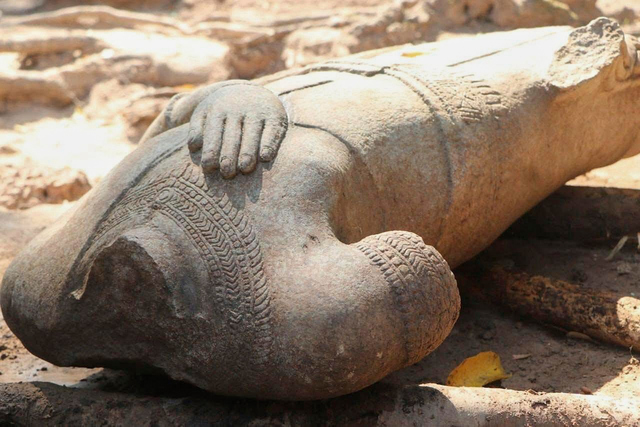
The Role of Ta Prohm and the Khmer Empire
Ta Prohm Temple, where the Buddha statue was discovered, is one of Angkor’s most famous and well-preserved temples. Built during the reign of King Jayavarman VII, it was initially dedicated to the king’s mother and served as a Buddhist temple. The temple’s sprawling structure, enveloped by massive tree roots and the remnants of Khmer architecture, stands as a testament to the grandeur of the Khmer Empire. The temple’s significance is further amplified by its association with Jayavarman VII, one of Cambodia’s most revered kings, known for his expansion of Buddhism and the architectural splendor of his era.
Jayavarman VII’s reign marked a cultural renaissance for the Khmer Empire, and his efforts to spread Buddhism across the empire helped shape Cambodia’s religious landscape. Ta Prohm Temple, with its intricate carvings and rich symbolism, reflects the king’s commitment to religious and cultural development.
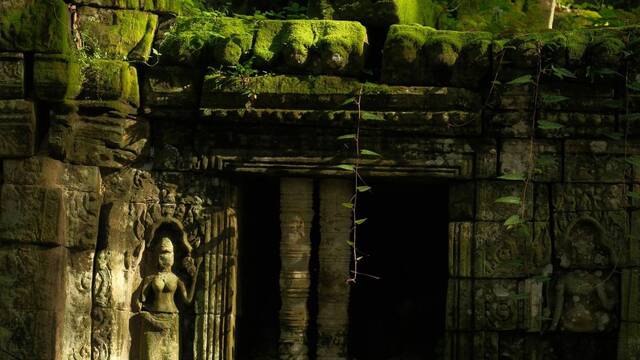
Challenges and Successes in the Restoration Process
Restoring a historical artifact as significant as the Buddha statue presents its challenges. While the statue has been virtually reassembled through modern scanning technology, the next step is to reunite the pieces physically. The restoration process is not only a technical endeavor but also a cultural one, as it involves careful preservation of the statue’s integrity while maintaining its historical accuracy.
Cambodia’s Apsara National Authority, under the guidance of Neth Simon, the archaeologist leading the excavation, is seeking approval from the Ministry of Culture and Fine Arts to physically restore and display the statue. The restoration process will ensure that the statue is displayed in its full glory for future generations, preserving a vital part of Cambodia’s cultural identity. Once the statue is reassembled, it will be displayed for public viewing, offering a tangible connection to Cambodia’s rich past and religious heritage.
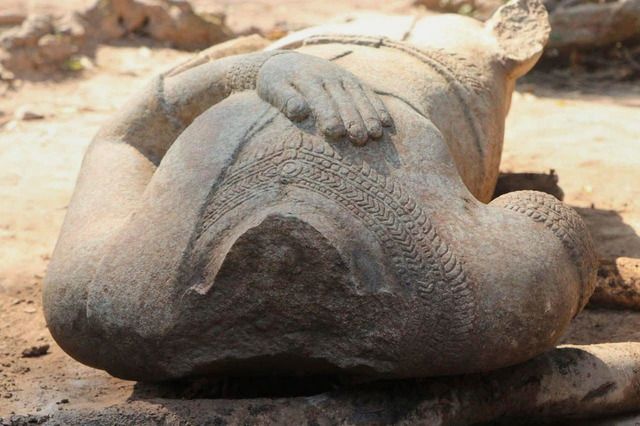
Angkor’s Cultural Legacy: Preserving the Past for the Future
The discovery and restoration of the Buddha statue underscore the ongoing efforts to protect and preserve Cambodia’s historical and cultural treasures. Angkor, a UNESCO World Heritage site, is home to countless monuments and statues that reveal the profound cultural significance of the Khmer Empire. The site continues to attract millions of tourists each year, who come to admire the architectural marvels of the temples and learn about Cambodia’s ancient history.
Preserving the artifacts and monuments of Angkor is critical for maintaining the cultural identity of Cambodia and fostering an appreciation of the country’s heritage. The Buddha statue’s restoration highlights the importance of safeguarding these treasures for future generations and ensuring that the stories of Cambodia’s past are not lost to time.
Conclusion: Reuniting the Pieces of the Past
The reunion of the Buddha statue’s head and torso is more than just an archaeological feat; it is a poignant reminder of Cambodia’s rich cultural and religious heritage. The statue’s restoration is not just about reassembling physical fragments, but about reconnecting with a past that continues to shape Cambodia’s identity. As efforts continue to preserve the Angkor Temple complex, this discovery serves as a testament to the resilience of Cambodia’s history and the ongoing importance of archaeology in understanding our shared cultural legacy. The reuniting of the Buddha statue will undoubtedly inspire awe and reflection, offering a glimpse into the artistic and spiritual grandeur of the Khmer Empire, and reminding us of the enduring power of history to connect us with our ancestors.
Video
Watch the full episode of Angkor Wat from Access 360 World Heritage.



